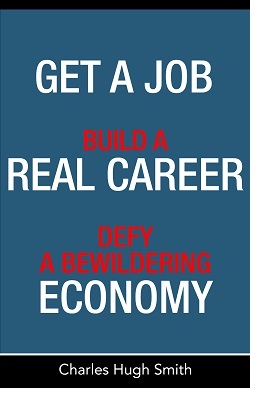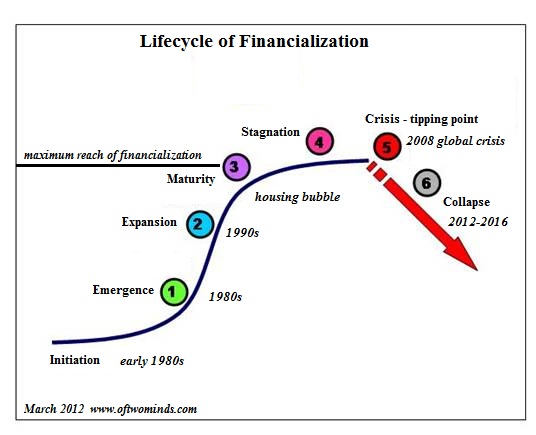The hard limits are hidden, and we will discover them only when it's too late to modify the self-destructive behavior and policies we've pursued as "safe" and "forever."
Why do hard limits matter? Because we only change when we've run up against them. Those extra few pounds we've put on? Humans being what they are, few change their behavior before the heart attack: the extra pounds stimulate high-minded attempts at reform that are soon abandoned as too painful and difficult. It takes the hard limit of a heart attack--change your diet and fitness or die--to actually trigger transformative changes.
This same dynamic is repeated throughout human life: debt piles up and we reckon we can maintain our Status Quo lifestyle with a consolidation loan, etc., but the only thing that really forces transformative change in spending/saving behavior is the hard limit of no more credit/bankruptcy.
Life without hard limits is a series of phony reforms to placate critics, fudged numbers, self-serving justifications and doing whatever is necessary in terms of appearances to keep doing what we're doing: make a show of skipping dessert in front of others, and then consume a carton of ice cream at home when nobody's looking.
We avoid change, pain and difficult endeavors if at all possible. This makes short-term sense: why take on the risks of changing what's worked for years/decades?
What do I mean by financial finagling? I mean expanding claims on real world assets without increasing real-world assets. Here's how this works in the real world:
1. The government wants to spend more money than it collects in tax revenue.
2. So the government sells a Treasury bond, i.e. a promise to pay interest in exchange for a chunk of cash.
3. The central bank creates money out of thin air and buys the government bond.
4. The central bank then holds the bond as an asset.
On the face of it, this finagling seems to be magic: the government got free money to squander propping up the Status Quo, and the central bank created an asset on its balance sheet. An asset: wow!
There seems to be no limit to this magic. It seems as if the central bank can print endless amounts of money to buy endless amounts of bonds which then fund endless amounts of government spending. Yes, the government pays interest on the bonds, but the central bank receives the interest payments and can refund the majority of this income to the government.
The net cost of this friction is so low, it's like a financial perpetual motion machine.
There doesn't appear to be any hard limits on government borrowing or central bank money creation. If nobody else wants to buy Treasury bonds because the private sector has lost faith in the state's ability to support all this debt, the central bank (the Federal Reserve) can print enough money to own virtually all Treasury bonds.
The Fed can also print enough money to buy most of the mortgages in the U.S., and most of the stocks, most of the empty malls, most of the junk bonds--everything that is no longer in demand in the private sector.
Where is the hard limit on this central-bank buying of assets? On the surface, there doesn't seem to be any limit.
There are limits, but they're operating beneath the surface. When the central bank and state create money to buy assets, what they're essentially saying is: the price for these assets discovered by the free market doesn't fit our political agenda, so we're suffocating price discovery to set prices where they will serve our perception-management needs.
The problem with suffocating price discovery is the market price is a critical piece of information participants need to know to make prudent risk management decisions. If this necessary information is suppressed or distorted by central bank/state asset purchases, all decisions made using the false price information will be systemically misinformed.
Robbed of the information needed to make good decisions, participants can only make bad decisions.
Another way of making the same point is: systemic risk is not visible until it explodes out of nowhere. It was piling up beneath the surface, but given the manipulation of pricing (of assets, risk, capital, etc.), this accretion of systemic risk was not visible to participants.
To central banks/states, that was the whole idea behind buying assets: to mask the systemic risk of centrally planned financial policies, and to nudge participants into making decisions that align with the desired political goals of the Power Elite.
For example, borrow money for next to nothing and use it to buy risk assets such as stocks, because this will create the illusion of growth and prosperity--and perception management is all that counts in maintaining political control.
We can visualize the diminishing returns on buying assets to suffocate price discovery as an S-Curve. The entire process of financialization is tracking an S-Curve of diminishing returns:
One way to understand the S-Curve is that doing more of what worked in the past is akin to pushing a string: it no longer generates the returns it did at the start.
So the Fed buys a trillion dollars in bonds and mortgages, and at first the stock market soars. The next trillion generates a hefty rise in stocks, but less than the first injection of monetary heroin, and so on: it takes ever-larger doses of monetary heroin to generate the "high" of another stock market rally.
So financial finagling has two parts:
1. Suffocating price discovery to push participants into doing what central planners want them to do, even though it is piling up systemic risk
2. Creating "assets" out of thin air doesn't create more land, iron ore, gold, human capital, knowledge, innovation, etc.--i.e. real-world assets.
So the net result of creating "assets" out of thin air is to depreciate real-world assets because these phantom assets are ultimately claims on real-world wealth.
In other words, creating $20 trillion in phantom assets doesn't actually add $20 trillion in real wealth to the economy; it simply adds an additional $20 trillion in claims on the existing real wealth.
Just as many on the edge of suffering a heart attack have no awareness of the risk they face, our financial system is blind by design to the enormous systemic risks generated by central planning distorting price discovery for the political purposes of perception management.
The hard limits are hidden, and we will discover them only when it's too late to modify the self-destructive behavior and policies we've pursued as "safe" and "forever."
Get a Job, Build a Real Career and Defy a Bewildering Economy(Kindle, $9.95)(print, $20)

Are you like me? Ever since my first summer job decades ago, I've been chasing financial security. Not win-the-lottery, Bill Gates riches (although it would be nice!), but simply a feeling of financial control. I want my financial worries to if not disappear at least be manageable and comprehensible.
And like most of you, the way I've moved toward my goal has always hinged not just on having a job but a career.
You don't have to be a financial blogger to know that "having a job" and "having a career" do not mean the same thing today as they did when I first started swinging a hammer for a paycheck
Even the basic concept "getting a job" has changed so radically that jobs--getting and keeping them, and the perceived lack of them--is the number one financial topic among friends, family and for that matter, complete strangers.
So I sat down and wrote this book: Get a Job, Build a Real Career and Defy a Bewildering Economy.
It details everything I've verified about employment and the economy, and lays out an action plan to get you employed.
I am proud of this book. It is the culmination of both my practical work experiences and my financial analysis, and it is a useful, practical, and clarifying read.
Test drive the first section and see for yourself. Kindle, $9.95 print, $20
"I want to thank you for creating your book Get a Job, Build a Real Career and Defy a Bewildering Economy. It is rare to find a person with a mind like yours, who can take a holistic systems view of things without being captured by specific perspectives or agendas. Your contribution to humanity is much appreciated."
Laura Y.
Gordon Long and I discuss The New Nature of Work: Jobs, Occupations & Careers (25 minutes, YouTube)
NOTE: Contributions/subscriptions are acknowledged in the order received. Your name and email remain confidential and will not be given to any other individual, company or agency.
| Thank you, Craig H. ($100), for your outrageously generous contribution to this site -- I am greatly honored by your steadfast support and readership. | | Thank you, Max C. ($30), for your extremely generous contribution to this site -- I am greatly honored by your support and readership. |




























